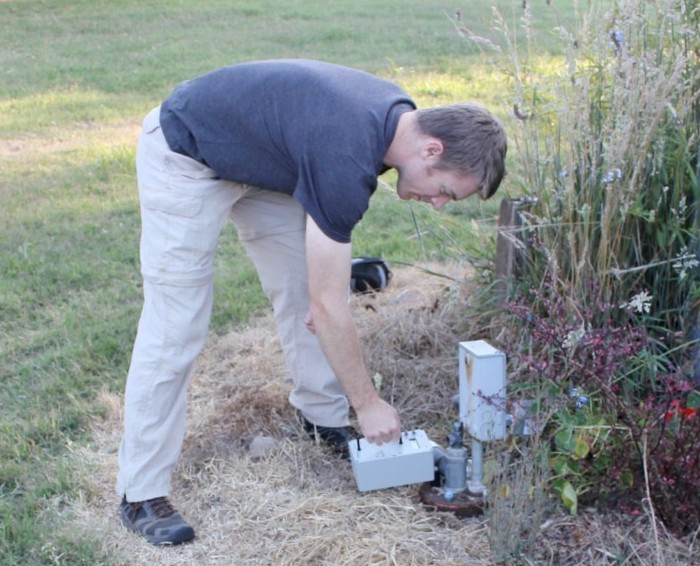Assisting Residents
Sonoma County maintains a diverse assemblage of land uses, all with different natural resource concerns. The RCD offers natural resource conservation assistance to all urban and rural property owners and land managers within its district. We have technical assistance available to residents in Sonoma County who may be concerned about:

Forest and Fuels Management
Sonoma County like many California counties is annually threatened by catastrophic wildfire, particularly in the wildland-urban interface (WUI). Our local topography, fuels, and Mediterranean climate make our County subject to periodic wildfires. Combined with 100 years of effective fire suppression across the state, these conditions have led to uncharacteristically high fuel loads which has resulted in several devastating wildfires recently impacting our community.
Fire is an essential ecological process in fire-dependent ecosystems, such as California wildlands. However, over a century of fire suppression has led to wildlands, woodlands and rangelands that are unable to withstand normal droughts, insect outbreaks or wildfires. The purpose of any fuels reduction project is to change the size and composition of the fuels in the forest, creating a break in fuel continuity. Doing so removes ladder fuels which can carry fire from the forest floor to the tree crowns where it can become a devastating fire that quickly spreads. The goal of fuels reduction is to create conditions that mimic the role of low intensity fire or other disturbances that once naturally thinned the forest.
The RCD has a long history of collaborating with local community and agency stakeholders to provide county residents with educational, science-based solutions, and cost share assistance. Our growing partnerships with federal, state and local partners support county and regional efforts that aim to aid forest landowners implement non-commercial forest improvement activities such as thinning, planting, pruning, and fuel hazard reduction to mitigate wildfire risk and improve forest health in this highly fire-prone region.

Managing Stormwater
In developed areas, roofs, pavement, and other impervious surfaces prevent stormwater from soaking into the ground. Instead, it runs over the land surface and directly into storm drains or small tributaries, and then into larger streams. Unable to handle the increased water volume and flow, these water bodies often experience eroded banks, incised channels, loss of habitat and aquatic life, and increased flooding and property damage. In addition, stormwater can carry a broad mix of harmful chemicals, bacteria, sediments, fertilizers, oil, and grease to nearby waterways and water bodies. Retaining as much stormwater as possible on the land— rather than letting it run directly into storm drains—can help keep harmful flows and pollutants out of our streams and rivers. Additionally, storing this stormwater for use in times of no rain or to increase groundwater infiltration can also be greatly beneficial to homeowners and watershed health. The RCD can provide financial or technical assistance with stormwater. Our comprehensive guidebook to managing stormwater is available for download: Slow it. Sink it. Spread it. Store it!

Monitoring Well Depth
Groundwater is an essential component to the health and function of our watersheds, including ecosystems and agricultural, rural and urban communities who depend on its supply. Working with local landowners and partners, the RCD assists a statewide groundwater monitoring effort called the California Statewide Groundwater Elevation Monitoring (CASGEM) program in several watersheds as well as leads a large scale monitoring effort in the Laguna de Santa Rosa Watershed. The goal of these monitoring programs is to assess seasonal and long-term trends in groundwater levels. If you live within prioritized watersheds and are interested in participating in a groundwater monitoring effort the RCD may be able to help.

Stream Care
Sonoma County streams are home to a wide variety of native fish, plants and wildlife. Our local streams support native fishes that include steelhead, coho salmon, and California freshwater shrimp. A number of these streams are also home to sensitive wildlife species such as the California red-legged frog. Residents living beside or near creeks, streams, and waterways often want to know how to best protect and care for water quality and the wildlife in their watersheds, and the RCD can provide technical resources and assistance.

Protecting Endangered Species
Sonoma County is home to more than 20 endangered or threatened plant and animal species, including coho and steelhead salmonids, Northern spotted owl, California freshwater shrimp, California red-legged frog, and the California tiger salamander. Property owners and land managers have asked how they can help protect endangered or threatened species. The RCD has programs and services for those who want to learn about protection of species.

Planting Native Vegetation/Removing Invasive Weeds
The overabundance of non-native invasive plants in Sonoma County threatens native plants and wildlife. Invasive species are marked by their ability to spread easily and rapidly. When native vegetation is crowded out by invasive plants, the result can include the decline of critical nesting habitat for migrating birds, diminished shade on streams that is vital for fish health, increased fire risk, and a breakdown of stream-bank stabilization. The RCD has technical assistance available for planting native vegetation and or removing invasive species.

Erosion Control
Eroding slopes, streambanks, and hillsides can threaten homes, buildings, crops, and roads, and can contribute large amounts of sediment to the waterways. Sediments can significantly harm species like coho and steelhead salmonid populations, which are found in the watersheds as well as coastal marine ecosystems. Technical assistance for erosion control is one of the RCD’s most long-standing and frequently sought services.

Community and School Gardens
A new partnership started in 2022, led by Sonoma County’s two Resource Conservation Districts, the School Garden Network, Conservation Works, and school district partners, this project is the culmination of years of research, experience, and conversation with dozens of schools, businesses, farmers, parents, students, teachers, non-profits, and local governments to define the most needed actions to support Farm to School programs in Sonoma County. We believe that the combination of implementation and planning to support Farm to School programs will make farm to lunch programs the norm instead of the exception and will have long lasting effects by building capacity for school districts to continue programming without grant support. This work will advance child well-being, economic growth, environmental resilience, and racial equity through farm to school systems that connect children to locally sourced whole foods and produce in cafeterias, classrooms, and school gardens.
We are expanding school garden technical assistance and capacity building, providing farm field trip experiences for schools not able to offer school garden programs, offering a harvest of the month program with culturally relevant and climate smart produce, sourced from small to midsize food producers, veteran food producers, socially disadvantaged food producers, and/or limited-resource farm households in California; and continuously working to identify barriers to and opportunities for the sustainable implementation of farm to school procurement relevant to districts countywide and regionally.




































